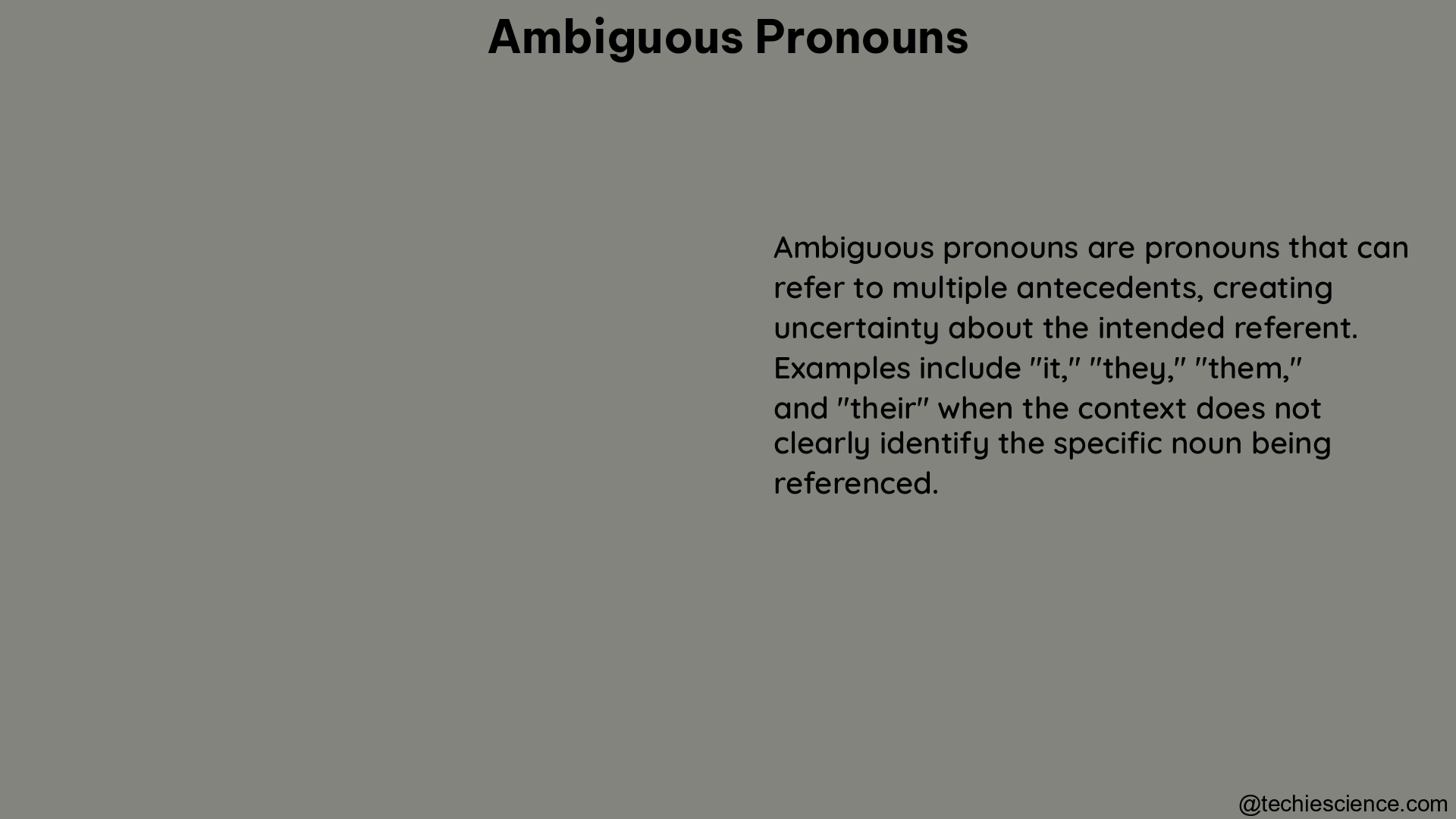Ambiguous pronouns are a common pitfall in English grammar that can significantly impact the clarity and effectiveness of written communication. This comprehensive guide delves deep into the intricacies of ambiguous pronouns, equipping you with the knowledge and strategies to identify and resolve these linguistic challenges.
Definition and Types of Ambiguous Pronouns
An ambiguous pronoun is a pronoun that has multiple possible antecedents, making it unclear which noun it refers to. This ambiguity can arise from various sources, including:
1. Ambiguous Pronouns
These are pronouns with multiple possible antecedents. For example: “Lan and his father went to see his favorite movie.” Here, “his” could refer to either Lan or his father.
2. Implied/Missing Pronouns
These use possessive adjectives (his, hers) instead of a true antecedent, which should be a noun. For example: “In Virginia Woolf’s Mrs. Dalloway, she explores the limits of modernism.” Here, “she” should refer to Virginia Woolf, not Mrs. Dalloway.
3. Vague Pronouns
These are pronouns with no actual antecedent. The sentence implies a pronoun without giving one. For example: “As nursing requires a high level of skill, they should receive correspondingly high salaries.” Here, “they” lacks a clear antecedent.
Examples and Corrections

Let’s dive into specific examples and their corrected versions to better understand how to address ambiguous pronouns.
Ambiguous Pronouns
Example: “John and Mark agreed to go to Disneyland, but when the day came he said no way.”
Correction: “John and Mark agreed to go to Disneyland, but when the day came, John said no way.”
Implied/Missing Pronouns
Example: “In Mrs. Dalloway, Virginia Woolf explores the limits of modernism.”
Correction: “Virginia Woolf explores the limits of modernism in Mrs. Dalloway.”
Vague Pronouns
Example: “Sometimes my boss yells at me because of his frustrations with things that have nothing to do with me, and sometimes he’s perfectly pleasant. I just sit back and take it.”
Correction: “Sometimes my boss yells at me because of his frustrations with things that have nothing to do with me, and sometimes he’s perfectly pleasant. I just sit back and take his unpredictability.”
Identifying and Fixing Ambiguous Pronouns
To identify ambiguous pronouns, look for sentences where a pronoun could refer to multiple nouns. To fix them, you can employ the following strategies:
1. Replace Pronouns with Specific Nouns
This can help clarify the antecedent. For example: “Joey helped Simon climb over the wall, getting Simon’s shoelace caught in the process.”
2. Recast the Sentence
Rearrange the sentence to make the antecedent clear. For example: “Noah jumped between their friends and the ballerinas, preventing a fight from breaking out on the dancefloor.”
Advanced Techniques for Resolving Ambiguous Pronouns
While the strategies mentioned above are effective, there are additional techniques you can utilize to tackle more complex cases of ambiguous pronouns:
1. Employ Parallel Structure
Maintaining a consistent grammatical structure can help eliminate ambiguity. For instance, “The teacher praised the students for their hard work” is clearer than “The teacher praised the students for his hard work.”
2. Use Demonstrative Pronouns
Demonstrative pronouns like “this,” “that,” “these,” and “those” can help specify the antecedent. For example, “The team celebrated their victory, and then they went out for a team dinner” can be improved to “The team celebrated their victory, and then the players went out for a team dinner.”
3. Leverage Contextual Clues
Carefully analyzing the context surrounding the pronoun can provide valuable insights into its intended antecedent. Consider factors such as the subject matter, tone, and overall narrative to make an informed decision.
4. Consult Style Guides and Grammar Resources
Refer to authoritative sources like the Chicago Manual of Style, the Associated Press Stylebook, or online grammar guides to ensure you’re adhering to best practices and industry standards.
Conclusion
Ambiguous pronouns can be a significant obstacle in effective written communication, but with the right strategies and techniques, you can master this aspect of English grammar. By understanding the different types of ambiguous pronouns, identifying them in your writing, and applying the appropriate corrective measures, you can elevate the clarity and precision of your written work.
Remember, the key to conquering ambiguous pronouns lies in maintaining a keen eye for detail, a deep understanding of grammatical principles, and a commitment to continuous learning and improvement. Embrace these tools, and you’ll be well on your way to crafting clear, unambiguous, and impactful written communication.
References
- Magoosh. (2021). Identifying and Fixing Ambiguous Pronouns on the ACT. Retrieved from https://magoosh.com/hs/act/ambiguous-pronoun/
- Reed College. (n.d.). Ambiguous Pronouns. Retrieved from https://www.reed.edu/writing/grammar_review/pronouns.html
- Swarthmore College. (n.d.). Pronoun Reference. Retrieved from https://www.swarthmore.edu/writing/pronoun-reference-0
- Cedarville University. (n.d.). Avoiding Vague and Ambiguous Pronoun References. Retrieved from https://www.cedarville.edu/-/media/Files/PDF/Writing-Center/Student/avoiding-vague-and-ambiguous-pronoun-references.pdf
- Rookwood Editing. (2021). What Are Ambiguous Pronouns? Retrieved from https://www.rookwoodediting.com/2021/04/what-are-ambiguous-pronouns/

The lambdageeks.com Core SME Team is a group of experienced subject matter experts from diverse scientific and technical fields including Physics, Chemistry, Technology,Electronics & Electrical Engineering, Automotive, Mechanical Engineering. Our team collaborates to create high-quality, well-researched articles on a wide range of science and technology topics for the lambdageeks.com website.
All Our Senior SME are having more than 7 Years of experience in the respective fields . They are either Working Industry Professionals or assocaited With different Universities. Refer Our Authors Page to get to know About our Core SMEs.